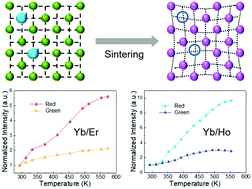Thermal enhancement of upconversion in lanthanide-doped Gd2Ti2O7 crystals via fast evaporation in a sol–gel procedure†
Abstract
A thermal quenching effect caused by the increased multi-phonon assisted non-radiative relaxation possibility greatly restricts the application of luminescent materials. Herein, a modified sol–gel method where the gels are achieved by an ultra-fast evaporation process is employed to prepare lanthanide doped Gd2Ti2O7 crystals, which leads to lattice contraction owing to the formation of vacancy defects. Upon increasing the temperature from 293 to 573 K, the red UC intensities of Er3+ and Ho3+ ions enhance about 5.6 and 9.6 times, respectively, which is attributed to the reduced energy migration from activators to vacancy defects at higher temperatures. These processes are fully reversible. Upon integrating the Gd2Ti2O7:Yb/Er crystals with a negative thermal quenching effect and the NaGdF4:Yb/Tm@NaYF4 nanocrystals with a positive thermal quenching effect, a high relative temperature sensitivity of 8.73% K−1 at 293 K is achieved. These crystals have potential applications not only in highly sensitive temperature sensing, but also in anti-counterfeiting with high security levels.



 Please wait while we load your content...
Please wait while we load your content...